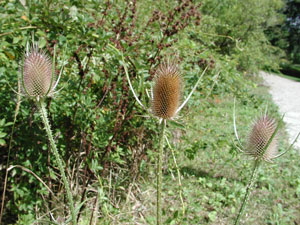Resource Library
Plant of the Week: Teasel
The University of Arkansas System Division of Agriculture does not promote, support or recommend plants featured in "Plant of the Week." Please consult your local Extension office for plants suitable for your region.
Plant of the Week
Teasel
Latin: Dipsacus fullonum

The wild landscape around us is an echo of the things that have gone before. Much of what we see along the highways and byways as we travel reflects the disturbance our farming, ranching and building efforts have wrought over the past generations. Efforts to put the genie back in the bottle and restore our native landscape to "natural" conditions are an uphill battle fighting one of the basic tenants of nature: the Darwinian principle of survival of the fittest. These non-native plants are tough competitors. Teasel (Dipsacus fullonum), now considered an invasive weed in most states, is an example of a plant that once served our needs well but was passed by in the rush to modernity.
Teasel is a biennial herb of the teasel family, with the best known garden member of this family being Scabiosa "daisies." The first year, teasel grows as a compact rosette of foot-long leaves that, in the spring of the second year, send up a 4- to 5-foot tall prickly stem bearing large opposite leaves. The stems are stout, sparsely branched and terminate in the distinctive flower head in midsummer.
The head is a compact, compound egg-shaped inflorescence to 4 inches long, which produces tubular, lavender to light purple blooms around the midriff of the inflorescence. As time proceeds, the bloom front progresses towards the top and bottom of the floral spike.
At the base of the congested blooms is a single stiff bract that extends out about as far as the petals of each flower. When the flower spike finishes blooming, these stiff bracts give the elongated inflorescence a pincushion-like look and feel. Also, at the base of the inflorescence is another, much larger set of slender, prickly bracts that curve upward and more or less enclose the bloom. When the plant completes flowering in the fall, it dies ahead of frost.
Teasel was introduced into this country early in our settlement for a very practical reason: it helped the housewife of the day produce the woolen thread to weave the homespun garments of the day. Not just any old teasel would work either. It had to be Fuller's teasel, which had a hooked tip on all of those hundreds of stiff bracts produced on the prickly inflorescence.
Until about 188, spinners used teasel heads to raise the nap on woolen fabric to make the finished product softer to the touch.
Because homespun clothing was a part of pioneer life, teasel plants were spread far and wide during the pioneer days of old. But other factors were also at work to help spread it far and wide. During the Victorian age, it was a popular grave-decorating addition to dried flower arrangements. In the Midwest, it is a common roadside weed around graveyards. To this day, it is still occasionally seen in dried flower arrangements.
Fuller's Teasel (subspecies sativus) was described by Pliney almost 2,000 years ago and was widely known and used throughout Europe before the settlement of this country. Its use here in the pre-industrial age was as natural then as is the use of a cell phone in the digital age. Times and practices change, and these echoes from the past remind us where we have been and how far we've come.
By: Gerald Klingaman, retired
Retired Extension Horticulturist - Ornamentals
Extension News - December 10, 2010
The University of Arkansas System Division of Agriculture does not maintain lists of retail outlets where these plants can be purchased. Please check your local nursery or other retail outlets to ask about the availability of these plants for your growing area.